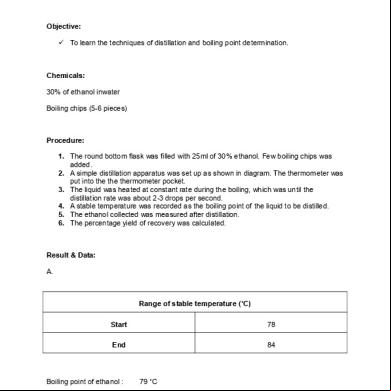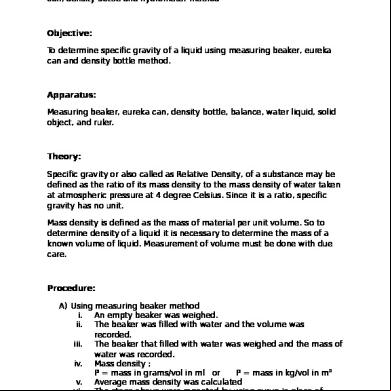Experiment 2 Chm207 Intermediate Organic Chemistry Distillation Technique And To Determine The Boiling Point Of A Liquid 2r5r5
This document was ed by and they confirmed that they have the permission to share it. If you are author or own the copyright of this book, please report to us by using this report form. Report 445h4w
Overview 1s532p
& View Experiment 2 Chm207 Intermediate Organic Chemistry Distillation Technique And To Determine The Boiling Point Of A Liquid as PDF for free.
More details 6h715l
- Words: 408
- Pages: 3
Experiment 2: Distillation technique and to determine the boiling point of a liquid
Objective: To learn the techniques of distillation and boiling point determination.
Chemicals: 30% of ethanol inwater Boiling chips (5-6 pieces)
Procedure: 1. The round bottom flask was filled with 25ml of 30% ethanol. Few boiling chips was added. 2. A simple distillation apparatus was set up as shown in diagram. The thermometer was put into the the thermometer pocket. 3. The liquid was heated at constant rate during the boiling, which was until the distillation rate was about 2-3 drops per second. 4. A stable temperature was recorded as the boiling point of the liquid to be distilled. 5. The ethanol collected was measured after distillation. 6. The percentage yield of recovery was calculated.
Result & Data: A.
Range of stable temperature (˚C) Start
78
End
84
Boiling point of ethanol :
79 ˚C
B.
Volume (ml)
Initial volume of ethanol in 25ml
30 ×100 =7.5 100
Volume of ethanol collected after distillation
6.9
Calculation of ethanol after distillation
6.9 ×100 =92 7.5
Questions/Discussions: 1. Draw the appratus needed for distillation.
2. Explain why we need to use boiling chips in the distillation process. Boiling chips absorb the heat and temperature will increase. Because of the chips has higher temperature than liquids, then the liquid that s with surface of boiling chips will boils. If a liquid is heated, it may go to temperature above its boiling point, resulting in sudden spurt. To avoid this spurting, boiling chips are added.
3. Ethanol have higher boiling point than propane. Draw the structure of ethanol and propane ann explain why. Ethanol Propane
Ethanol forms bonds between oxygen and hydrogen molecule whereas propane form only hydrogen bonds. Hydrogen bonds are weaker than hydro-oxi bonds thus it takes more heat to break O-H bond than H-H bonds.
4. What is the thereotical value of ethanol’s boiling points? Compare the value with your experimental value of boiling point. Explain why it is differ. The thereotical value is 78˚C while experimental value is 79˚C. During the distillation, at 92% ethanol-water mixture forms azeotrope which hampers further distillation. So ethanol can be made 100% pure.
Conclusion: As a conclusion, the techniques of distillation was learned and the boiling point of ethanol was determined. Only 92% of ethanol was recovered from the distillation process. This may be due to the ethanol vapour is still trap in the apparatus during the boiling process.
Objective: To learn the techniques of distillation and boiling point determination.
Chemicals: 30% of ethanol inwater Boiling chips (5-6 pieces)
Procedure: 1. The round bottom flask was filled with 25ml of 30% ethanol. Few boiling chips was added. 2. A simple distillation apparatus was set up as shown in diagram. The thermometer was put into the the thermometer pocket. 3. The liquid was heated at constant rate during the boiling, which was until the distillation rate was about 2-3 drops per second. 4. A stable temperature was recorded as the boiling point of the liquid to be distilled. 5. The ethanol collected was measured after distillation. 6. The percentage yield of recovery was calculated.
Result & Data: A.
Range of stable temperature (˚C) Start
78
End
84
Boiling point of ethanol :
79 ˚C
B.
Volume (ml)
Initial volume of ethanol in 25ml
30 ×100 =7.5 100
Volume of ethanol collected after distillation
6.9
Calculation of ethanol after distillation
6.9 ×100 =92 7.5
Questions/Discussions: 1. Draw the appratus needed for distillation.
2. Explain why we need to use boiling chips in the distillation process. Boiling chips absorb the heat and temperature will increase. Because of the chips has higher temperature than liquids, then the liquid that s with surface of boiling chips will boils. If a liquid is heated, it may go to temperature above its boiling point, resulting in sudden spurt. To avoid this spurting, boiling chips are added.
3. Ethanol have higher boiling point than propane. Draw the structure of ethanol and propane ann explain why. Ethanol Propane
Ethanol forms bonds between oxygen and hydrogen molecule whereas propane form only hydrogen bonds. Hydrogen bonds are weaker than hydro-oxi bonds thus it takes more heat to break O-H bond than H-H bonds.
4. What is the thereotical value of ethanol’s boiling points? Compare the value with your experimental value of boiling point. Explain why it is differ. The thereotical value is 78˚C while experimental value is 79˚C. During the distillation, at 92% ethanol-water mixture forms azeotrope which hampers further distillation. So ethanol can be made 100% pure.
Conclusion: As a conclusion, the techniques of distillation was learned and the boiling point of ethanol was determined. Only 92% of ethanol was recovered from the distillation process. This may be due to the ethanol vapour is still trap in the apparatus during the boiling process.










